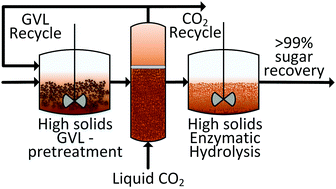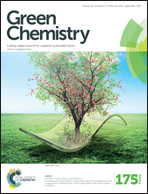A mild biomass pretreatment using γ-valerolactone for concentrated sugar production†
Abstract
Here we report that γ-valerolactone (GVL), a biomass-derived solvent, can be used to facilitate the mild pretreatment of lignocellulosic biomass. An 80% GVL, 20% water solvent system was used to pretreat hardwood at the mild temperature of 120 °C with an acid loading of 75 mM H2SO4. Up to 80% of original lignin was removed with 96–99% of original cellulose retained in the pretreated substrates. The use of a mild temperature and low acid concentrations caused negligible degradation of sugars. Up to 99% of the original glucan and 96% of the original xylan could be recovered after pretreatment. The pretreated substrate was quantitatively converted to sugars (99% and 100% total glucose and xylose yield) with an enzyme loading of 15 FPU g−1 glucan. These digestibilities were three times higher than those obtained when using other organic solvents such as tetrahydrofuran or ethanol, and 20 times higher than when pure water was used during pretreatment. Over 99.5% of GVL could be recovered by liquid–CO2 extraction of the pretreated slurries while removing less than 1% of the sugars. This approach produced pretreatment slurries that could easily undergo high-solids (30% w/v) enzymatic hydrolysis without any substrate washing or drying. We obtained glucose and xylose yields of up to 90% and 97%, respectively, and generated sugar streams with sugar concentrations up to 182 g L−1.

- This article is part of the themed collection: 3rd International Symposium on Green Chemistry


 Please wait while we load your content...
Please wait while we load your content...